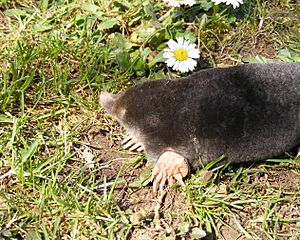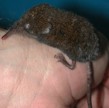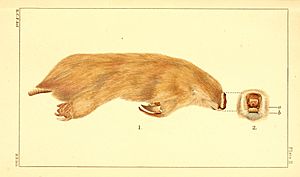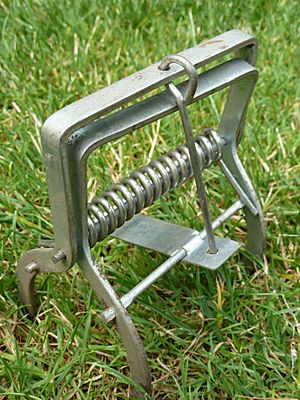Mole (animal) facts for kids
Moles are small mammals that live mostly underground. They have round bodies and soft, velvety fur. Moles have tiny, hard-to-see eyes and ears. Their back legs are small, but their front legs are short and very strong. They have large paws perfect for digging.
The word "mole" comes from the Latin word talpa. Moles live in many parts of North America, Europe, and Asia.
Gardeners sometimes see moles as pests. However, moles help the soil, gardens, and the environment. They dig tunnels, which helps air get into the soil. They also eat slugs and other small creatures that might harm plant roots. Moles are also food for other wildlife. Their main diet is earthworms and other small animals found in the soil.
Contents
What's in a Name?
Long ago, in Middle English, moles were called moldwarps. This word means "earth-thrower." This is because moles throw up soil when they dig their tunnels.
You might have heard the saying, "Don't make a mountain out of a molehill." This means don't make a small problem seem much bigger than it is. People first used this saying a long time ago, during the Tudor times in England.
Male moles are called "boars." Female moles are called "sows."
Amazing Mole Abilities
Breathing Underground
Moles are special because they can handle more carbon dioxide than most other mammals. This is because their blood has a unique type of hemoglobin. Hemoglobin is what carries oxygen in the blood. Moles' hemoglobin is very good at picking up oxygen.
Moles also use oxygen very well by breathing air they've already exhaled. This helps them live in places with low oxygen, like their underground tunnels.
An Extra Thumb!
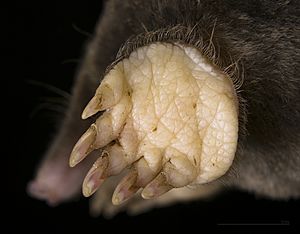
Moles have a special extra thumb on each front paw. It's called a prepollex. This extra thumb helps them dig even better. While their other fingers have many joints, this extra thumb has one strong, curved bone.
This special thumb grows differently from their other fingers. It's like the extra "thumb" that giant pandas have, which helps them hold bamboo. But the mole's extra thumb developed on its own. It's unique to moles and not found in shrews, which are their close relatives.
What Moles Eat
Moles are omnivores, meaning they eat both plants and animals. But they mostly eat earthworms and other small creatures living in the soil. Their tunnels are like "worm traps." Moles can feel when a worm falls into a tunnel and quickly go to catch and eat it.
Moles have a special trick: their saliva contains a toxin that can paralyze earthworms. This means they can store living worms for later! They build special underground "larders" (like pantries) just for this. Scientists have found these larders with over a thousand earthworms stored inside! Before eating earthworms, moles squeeze them between their paws to push out any dirt.
The star-nosed mole is super fast. It can find, catch, and eat food quicker than you can blink!
Mole Reproduction
The time of year when moles breed depends on the species. Generally, it's from February to May. Male moles look for females by making high-pitched squeals and digging new tunnels.
Eastern moles (found in North America) are pregnant for about 42 days. They usually have three to five babies, called pups, in March or early April.
Townsend moles mate in February and March. Their two to four pups are born in March or April after about one month of pregnancy. The Townsend mole is an endangered species in the United States and Canada.
Coast moles have two to five pups between March and April.
Young moles leave their nest about 33 days after they are born to find their own homes. They move away from their mother's area around 5 to 6 weeks old. They can start having their own babies the spring after they are born.
Mole Social Life
Moles are usually solitary animals. This means they live alone and only come together to mate. Their territories might overlap, but moles tend to avoid each other. If male moles do meet, they might fight fiercely.
Types of Moles
All true moles belong to a family called Talpidae. This family also includes some of their close relatives, like shrew moles and desmans. Shrew moles are a bit like a mix between moles and shrews.
Scientists used to group moles with hedgehogs, but they are not closely related. Moles are now part of a larger group called Eulipotyphla, which includes shrew-like animals.
Here are some of the main groups of moles:
- New World Moles (Scalopinae): These moles live in North America and parts of Asia.
* The Star-nosed mole is one unique type, known for its star-shaped nose. * Other types include the Hairy-tailed mole and the Eastern mole.
- Old World Moles, Desmans, and Shrew Moles (Talpinae): These live in Europe and Asia.
* Desmans are semi-aquatic (live partly in water) relatives of moles, like the Russian desman. * Many well-known moles, like the European mole, are in this group. * Japanese shrew moles are also part of this group.
- Asian Shrew Moles (Uropsilinae): These moles are found in China, Bhutan, and Myanmar.
Other "Moles"
Many burrowing animals look like moles because they live underground and have similar needs. This is called convergent evolution. It means different animals develop similar features because they live in similar environments.
Two groups of animals are often called "moles" but are not true moles at all: golden moles and marsupial moles. They look very similar to true moles but are not related. You can often tell them apart by the shovel-like patches on their noses, which they use to "swim" through sandy soil.
Golden Moles
Golden moles live in southern Africa. They are not closely related to true moles. Instead, they are more closely related to animals like elephants, manatees, and aardvarks! This might sound surprising, but it's how their family tree works.
Here are some examples of golden moles:
- Arends' golden mole
- Cape golden mole
- Giant golden mole
- Hottentot golden mole
- Grant's golden mole
Marsupial Moles
Marsupial moles live in Australia. They are even more distantly related to true moles than golden moles are. Marsupials are animals that carry their young in a pouch, like kangaroos or koalas.
So, marsupial moles are more closely related to other Australian marsupials than they are to true moles or golden moles.
There are two main species of marsupial moles:
Moles and Humans
Mole Fur
Moles have very soft, velvety fur. Unlike animals that live above ground, a mole's fur doesn't lie in one direction. This is helpful for moles because it means they can move backward underground easily without their fur getting "brushed the wrong way."
The fur is very soft and flexible. Years ago, Queen Alexandra of the United Kingdom even ordered a mole-fur garment. This helped make mole fur popular and created a business in Scotland, where moles were a big problem for farmers. Hundreds of mole pelts (skins) were cut into rectangles and sewn together to make coats. The natural color of mole fur is a grayish-brown, called "taupe," which comes from the French word for mole.
Today, the word "moleskin" is used for a tough cotton fabric, not just mole fur.
Moles as Pests
In some places, moles are seen as agricultural pests. This is because their digging can cause problems for farmers. For example, they can:
- Mix soil into animal feed, making it less tasty for livestock.
- Cover grass with fresh soil, reducing how much food animals can eat.
- Bring stones to the surface, which can damage farm machines.
- Harm young plants by disturbing the soil around their roots.
- Help weeds grow by exposing fresh soil.
- Damage drainage systems.
Moles also dig tunnels and create molehills in lawns. This can make lawns look messy. Moles don't eat plant roots, but their tunnels can sometimes cause plant roots to dry out.
People sometimes try to control moles using traps or poisons. However, there are also humane ways to deal with moles. You can use traps that catch the mole alive so it can be moved somewhere else. In gardens, the damage from molehills is mostly how it looks. You can simply remove the soil from the molehills. This lets the moles keep living in their tunnels underground. But sometimes, tunnels near the surface can collapse, leaving small, messy lines in the lawn.
Moles in Archaeology
Moles can actually help archaeologists! As they dig their tunnels, moles sometimes bring small artifacts (old objects made by humans) to the surface. By looking at molehills for pieces of pottery or other small items, archaeologists can find clues about where people used to live.
See also
- Molecatcher
- Molehill


